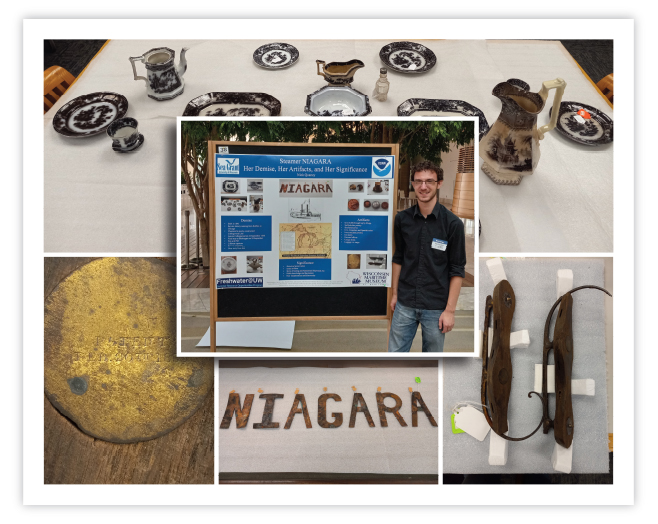
My name is Nick Quaney, and I was a summer research scholar for the Summer Research Opportunities Program through Freshwater@UW. My research subject from June 2023 to August 2023 was looking at shipwreck artifacts at the Wisconsin Maritime Museum in Manitowoc, Wisconsin. My specific focus was on the shipwreck of the sidewheel steamer NIAGARA. NIAGARA was a “palace steamer,” a term applied to a type of ship from the 1840s-1850s known for innovative design and extravagant luxury. Built-in 1845, NIAGARA ran from Buffalo to Chicago, being chartered to similar routes around the Great Lakes throughout her career. In 1856, she was chartered to the Collingwood Line out of Ontario, Canada, and on this route, from Collingwood to Chicago, she would meet her fate.
On 24 September, 1856, NIAGARA caught fire off the coast of Port Washington, Wisconsin. She burned quite quickly, and the passengers had trouble abandoning ship in such a chaotic situation. One of the lifeboats capsized, with the other being launched successfully, but many passengers had to jump into the cold Lake Michigan water, grabbing onto boards thrown overboard by the crew. Out of some 300 passengers on board, over 60 lost their lives.
The wreck of NIAGARA lies under 50 feet of water just off Belgium, Wisconsin. Due to her burning, not much is left of her, but in the mid 1960s, divers began to take the priceless artifacts that survived the sinking. It is unknown how many artifacts were looted from NIAGARA, but what is known is the amount that was taken by one man: Allen “Butch” Klopp.
Butch Klopp was one such diver who took artifacts from NIAGARA and other wrecks in the Great Lakes, but rather than trying to sell them or add to a private collection, Klopp tried to make his own museum. Through financial troubles over decades, the museum went out of business, and the artifacts he had sat unseen from the public eye until 2021, when the entire Klopp Collection was donated to the Wisconsin Maritime Museum. The collection, in total, comprises over 10,000 artifacts from numerous different shipwrecks, with at least 3,000 being from NIAGARA alone. It was these artifacts that I looked at for my research.
Using maker’s marks and pattern analysis on countless numbers of ceramics, knives, bottles, coins, and plenty of unique items, I found many of the origins of these artifacts, from who made them and where, to a rough estimate of when they were made. Many of the plates, bowls, cups, and saucers were English ceramics, and the hundreds of pocket knives were also of English manufacture. But some items stood out among the others. For example, a pair of ice skates happened to have a patent date on them, and through tracking down the exact patent, I found it was made by a local inventor in Meriden, Connecticut, patented on 20 February 1855, a little over a year before NIAGARA sank.
Those two months this summer have been an incredible experience, and certainly one that is a rare opportunity for not just a researcher, but anyone in the archaeological or historical field. Almost all of the artifacts I researched were in beautiful condition for surviving a fire and being underwater for over 150 years. To see and touch such intact and stunning objects, and knowing the history behind them, is an exhilarating, but also sorrowful experience. While these artifacts are treasures, priceless relics from a bygone era, they are tragic objects as well. The burning of NIAGARA was a tragedy, a horrific event that claimed the lives of many men, women, and children, and the story needs to be told.
The artifacts, and the information I researched, will eventually be exhibited by the Wisconsin Maritime Museum, to share the beauty, and the sorrow, of these objects, but most importantly, to show them to the public once more, so that everyone can share in the knowledge, and the history, of NIAGARA.